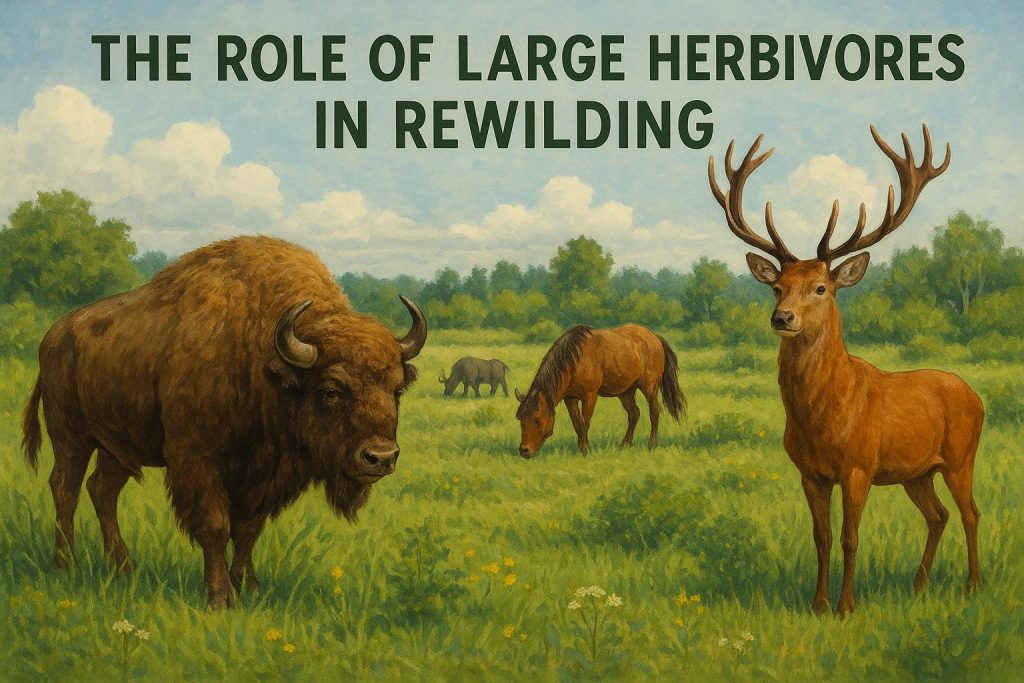
The Role of Large Herbivores in Rewildering
The Importance of Large Herbivores in Rewilding
Rewilding represents a forward-thinking approach in ecological restoration focused on the reintroduction of key species to reinstate natural processes and enhance biodiversity. Central to this approach is the role played by large herbivores. These animals exert a significant impact on ecosystems, influencing landscape structure, species composition, and ecological dynamics in diverse and intricate ways.
Ecological Impact of Large Herbivores
Large herbivores such as bison, elephants, and deer are vital in the formation and maintenance of landscapes and biodiversity. These creatures alter vegetative structures through grazing, thus shaping the environment in ways that support a variety of other species. The grazing actions of these animals help manage plant populations, influencing the food chain from producers to apex predators. By consuming specific vegetation types, these herbivores help create varied habitats that can support other life forms. For instance, when deer graze within a forest, they may impede the growth of trees, in turn creating open spaces that are colonized by grasses and wildflowers. These developments form crucial habitats for numerous insects and ground-nesting bird species.
Influence on Vegetation and Soil
Large herbivores significantly affect vegetation structure and soil dynamics through their movement and foraging patterns. Their grazing prevents the unchecked growth of certain plant species, helping maintain an ecologically balanced system. Additionally, through trampling, these animals enhance soil aeration, which boosts water infiltration and augments nutrient cycling. This behavior results in improved soil fertility that benefits both the plant and animal communities relying on the ecosystem for survival. Consequently, areas with a healthy population of large herbivores often display more robust vegetation and greater ecological health.
Seed Dispersal and Habitat Degradation Prevention
Serving as effective agents for seed dispersal, large herbivores help transport seeds over expansive areas through their consumption of fruits and plant matter. This inherent behavior enables the propagation of plant species across vast areas, facilitating biodiversity and aiding habitat regeneration. The maintenance of interconnected ecological networks owes a significant debt to the seed dispersal capabilities of these animals. Beyond their roles in seed dispersal, large herbivores help in mitigating habitat degradation by controlling the populations of invasive or overpopulated species. Through their selective feeding habits, they preserve ecological equilibrium, providing stable conditions within the habitat.
Case Studies in Rewilding
On a global scale, rewilding initiatives have capitalized on the ecological services provided by large herbivores to restore ecosystems. One notable example is Rewilding Europe, an organization that has actively participated in the reintroduction of species like the European bison and konik horses to regions where they were historically present but have since disappeared. These efforts have yielded productive outcomes, illustrated by enhanced plant diversity and improved habitats for the residing wildlife.
In Africa, elephants serve as key ecosystem engineers, transforming landscapes to sustain savanna ecosystems that in turn support a myriad of species. As a case in point, the foraging actions of elephants prevent tree encroachment in savannas, thereby maintaining open grassland areas necessary for different forms of wildlife. Similarly, in North America, bison have been reintroduced into grasslands, rekindling these ecosystems and fostering both plant diversity and the resurgence of other native species. Bison grazing patterns help control the spread of woody plants in grasslands, maintaining the landscape dynamics typical to the habitat.
Challenges and Considerations
Despite the apparent ecological benefits of rewilding initiatives involving large herbivores, challenges abound. One aspect of concern is the seamless reintroduction of these species, which demands thorough planning, especially to mitigate possible human-wildlife conflicts. Large herbivores can impact agricultural areas and their presence in densely populated regions may incite conflicts with human populations. Thus, effective management strategies are essential to minimize these impacts. Methods such as the establishment of wildlife corridors and strategically placing fences can help delineate boundaries and mitigate negative interactions with humans.
Another vital consideration is maintaining genetic diversity within rewilded populations to promote healthy, disease-resilient communities. Inbreeding can be a significant threat within small or isolated populations, thus rewilding efforts need to prioritize genetic variation to ensure longevity and adaptability. By doing so, the populations will be more resilient to changes in the environment and potential disease outbreaks.
Conclusion
Large herbivores are of unparalleled importance to the success of rewilding initiatives. The ecosystem roles they fulfill through their interactions with vegetation, soil, and other species lead to healthier, more resilient landscapes. As humanity moves forward with rewilding projects, integrating scientific insights with active community engagement will play a pivotal role in surmounting existing challenges. Successful rewilding involves collaboration between scientists, conservationists, policy experts, and local communities. This concerted effort will ensure the sustained reintroduction of large herbivores, which not only restore natural ecosystems but also guarantee that human and wildlife interactions remain harmonious and mutually beneficial. Through careful management and community involvement, rewilding can indeed pave the way for revitalized ecosystems and enriched biodiversity.